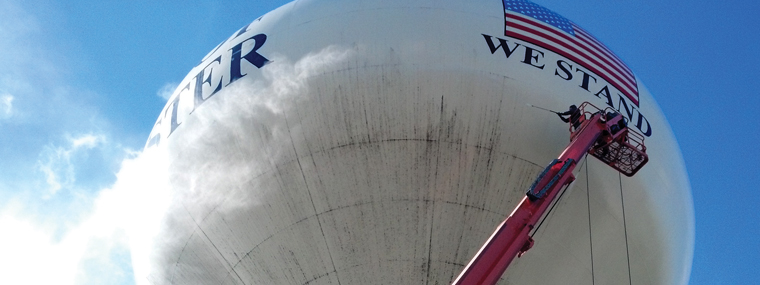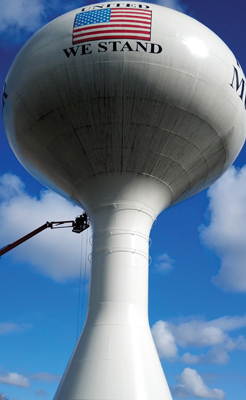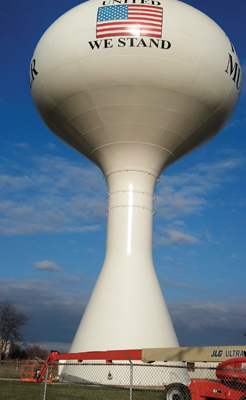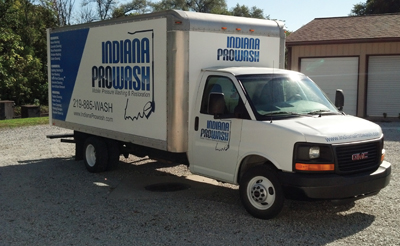
What a Mess! Cleaning Water Towers
by Greg Rentschler / Published April 2014

In 2013, Alkota Cleaning Sys-tems announced the launch of Mess Quest (www.messquest.net), a search for the world’s worst industrial cleaning jobs. Alkota President, Gary Scott, explains, “Let’s be honest: some of the messes our customers have to deal with are more than just demanding, they’re actually interesting.” Scott continues, “We’re in a great industry that doesn’t get the attention we believe it deserves. By throwing a spotlight on the extremes in clean, we get to celebrate the experience our customers go through every day and have fun at the same time.” One of the interesting entries that has been submitted to the Mess Quest competition came from Greg Rentschler, Owner, of Indiana ProWash and the parent company, TimberSeal, LLC, located in Valparaiso, IN. This job entailed cleaning a municipal water tower 135 ft in the air and is highlighted below. For more information on Rentschler’s companies, visit www.IndianaProWash.com or www.timberseal.net.
What Needs Brought About Your Company?
Indiana ProWash was actually spun off from our parent company, TimberSeal, LLC, in 2012. After 17 years of trying to cross promote different markets within our company, we finally decided the commercial cleaning needed to be a company of its own for marketing and branding purposes. We were being approached by local businesses and municipalities for work after finding us on the Web, but when we started marketing for the work, the TimberSeal name wasn’t fitting and left a bit of confusion with the customer. We also did not want to dilute the TimberSeal brand into which we put so much time and effort, hence Indiana ProWash was born.
What Are the Main Services Your Company Offers and What Is Your Coverage Area?
 Indiana ProWash services the Great Lakes region, which includes Indiana, Illinois, Michigan, and Ohio. We provide multi-surface cleaning solutions for our clients, which can include anything from interior shop floor cleaning to water tank and tower cleaning. While the project will vary from customer to customer, we specialize in evaluating the individual project’s cleaning needs and adapting our capabilities to provide the best cleaning results. Indiana ProWash also provides water reclamation and recycling services where needed.
Indiana ProWash services the Great Lakes region, which includes Indiana, Illinois, Michigan, and Ohio. We provide multi-surface cleaning solutions for our clients, which can include anything from interior shop floor cleaning to water tank and tower cleaning. While the project will vary from customer to customer, we specialize in evaluating the individual project’s cleaning needs and adapting our capabilities to provide the best cleaning results. Indiana ProWash also provides water reclamation and recycling services where needed.
In Regards to Cleaning Water Towers, What Is a Typical Situation?
Water towers always present a certain set of challenges for sure. When a cleaning project is 135 ft up in the air, you generally don’t even need to be nearby to see the issues at hand. In general, water towers commonly suffer from excessive dirt, algae, and mildew accumulation on the lower portion of the spheroid. This issue quickly becomes an eyesore to the community, but, even more importantly, it begins to break down and damage the very expensive finish on the tank if not cleaned regularly.
What Are the Challenges Involved in Cleaning Water Towers, and How Do You Overcome Those Challenges?
There are a few challenges when it comes to cleaning a water tower with access being the most obvious. When I say access, I not only mean how to access the height but also how to get a lift in and around the tower in order to be able to reach the areas needing service. Some towers are easy as they may be out in the open with no surroundings, while others will have many obstacles in the way, making access to certain sides of the tower difficult. Evaluating access is a critical step in deciphering your equipment needs and pricing for the cleaning of the tower. While the height of the tower can often be obtained by the municipality, you’ll always have to do a little math and footwork to determine what lift equipment is the most suitable for the job.
Once you decipher your lift needs, you will now need to evaluate the ground it will be driving on. In the best case scenario, you’re in an open field with level, compacted ground around you. It’s not out of the question though to run into sandy soils, retention berms, or fencing that you’ll have to maneuver around. Softer soils will often need layers of protection as well since an average lift can weigh upwards of 45,000 lbs and can create some serious ruts.
Scheduling is another challenge when it comes to water towers. Weather plays a significant role in when a tower can be safely cleaned. The possibility of rain, lightning, thunderstorms, and high winds all have to be assessed days ahead of the project in order to complete it successfully. Some of the lift equipment used can cost upwards of $2,000 a day so getting held up by the weather for even one day can have a significant impact on your project and quickly turn it into a losing financial situation.
How Long Does a Typical Water Tower Cleaning Job Take, and What Are the Steps Involved in Cleaning a Water Tower?
 Using our process and equipment, a 135-ft water tower can generally be cleaned in about 12–16 hours. Our process involves using the lift to access the spheroid portion of the tower and washing it from the top down. The algae and dirt accumulation can, at times, form a crust on the outside making it difficult to remove, therefore, we apply a proprietary detergent to the exterior and allow it to soften and break down the contaminants. After a short dwell time, the areas will often be treated again before the wash process begins to further help loosen the material. The dwell time and amount of detergent required will vary depending on the severity of the algae and dirt accumulation on the tower as well.
Using our process and equipment, a 135-ft water tower can generally be cleaned in about 12–16 hours. Our process involves using the lift to access the spheroid portion of the tower and washing it from the top down. The algae and dirt accumulation can, at times, form a crust on the outside making it difficult to remove, therefore, we apply a proprietary detergent to the exterior and allow it to soften and break down the contaminants. After a short dwell time, the areas will often be treated again before the wash process begins to further help loosen the material. The dwell time and amount of detergent required will vary depending on the severity of the algae and dirt accumulation on the tower as well.
After the detergents do their job, it’s time to wash. For this, we utilize two hot water skids generally six eight gpm each. The units are ‘tipped down’ to a pressure just above the point of safe removal. The goal is to remove the contaminants at an efficient rate without inflicting any damage to the paint on the tower. Typically, this will require something in the range of 1000–1500 psi 12 inches or so from the surface. Starting from the upper portion of the spheroid, we begin washing the tower and continue to push the contaminants down the pedestal or base below.
What Equipment and Supplies Were Used in the Cleaning, and How Did They Help?
Our Alkota 4355 hot water pressure washers are real workhorses for us in this line of work. Outside of being extremely durable and reliable, we get a great heat rise out of the burner systems. High heat isn’t typically needed with water towers, but there are other projects where it will make all the difference in the world. We also utilize a lot of extension wands for reach, downstream injectors for chemical application, and, of course, personal protective equipment to stay safe and dry during the process. With regard to protective gear, we suit up in waterproof protective boots, rain bibs, raincoats, and safety glasses/goggles or shield. All employees must also wear an OSHA-approved fall- arrest harness when using the lift.
How Do You Determine Billing for Water Tower Cleaning?
 Pricing a water tower for cleaning comes down primarily to the labor involved, equipment and supplies needed, and the amount of travel required. Compile these variables with your needed profit, and we can successfully price out a tower for cleaning and submit a profitable bid for the project. As with any project, you need to have a firm grasp on your costs of doing business or it can become a losing situation very quickly.
Pricing a water tower for cleaning comes down primarily to the labor involved, equipment and supplies needed, and the amount of travel required. Compile these variables with your needed profit, and we can successfully price out a tower for cleaning and submit a profitable bid for the project. As with any project, you need to have a firm grasp on your costs of doing business or it can become a losing situation very quickly.
Some Words of Wisdom for Cleaning Water Towers
1. Fear of Heights: 135 ft down looks a lot farther than 135 ft up!
2. Swaying Lifts: With no wind at all, the basket on a 135-ft lift moves. Add in 10 mph winds, and it can sway three–four ft left to right.
3. Proper Insurance: Make sure you are properly insured for this work. Anything higher than three stories, generally, will not be covered under a typical GL policy.
4. Proper Training: A 135-ft water tower isn’t the place where you want to begin to learn how to run a man lift. Get OSHA training and always use the appropriate safety equipment.





